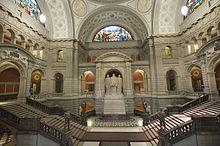The three confederates
The three confederates is the name of a statue by James Vibert (another name is Rütligruppe ). It is located in Bern and forms the center of the domed hall of the Federal Palace . The statue was unveiled in 1914 after artistic disagreements caused a twelve year delay.
description
Werner Stauffacher , Walter Fürst and Arnold von Melchtal stand on a pedestal, framed by an arch . According to the founding legend, these men are said to have founded the Confederation with the Rütli oath . Seriously, they each hold an outstretched hand on the federal letter , which Walter Fürst is holding in his left hand. The seals of the Drei Waldstätten are visible on the rolled up document . The figures are abstract, strictly symmetrical and block-like. Vibert deviated from the usual Rütli oath gestures with raised oath hands, so that from different angles no figure covers the other.
The total weight of the figures is 24 tons. The statue is made of the limestone Botticino with cream-colored clay, which comes from Botticino near Brescia . It is one of the few types of stone of foreign origin that has been processed in the Federal Palace (otherwise Swiss building material is almost exclusively used). The entablature and the pillars of the frame are made of a similar yellowish limestone that was quarried near Laufen . The stepped plinth at the base of the group of figures, made of a rare dark red limestone with white veins from the area near Yvorne , is particularly decorative, and continues at the side with pieces from Marbre d'Arvel from Villeneuve . The ornamental designed floor before the Rütli group from the reddish-yellowish Kalkbrekzie Rouge Jaspé and her gray variety Gris de Roche from a quarry near Roche , with Italian Carrara marble and Petit granite from Belgium is a work of historical significance Marbrerie Doret & Dentan from Vevey .
On the stairs in front of it there are more statues by James Vibert: The four mercenaries , which are modeled on warriors of the 16th century, represent the four national languages and at the same time form a guard of honor for the three confederates.
History of origin
The creation of the statue was preceded by a long and difficult process. On June 15, 1898, the Federal Council announced a design competition for the statue to be erected in the domed hall, with Hans Wilhelm Auer , the architect of the Federal Palace, having already determined the motif. A model had to be submitted that was one tenth of the later size. Half a year later, the jury reduced the number of participants to five. They had to create another model of a third of the statue to be built later. Finally, in September 1899, the jury commissioned the sculptor Hermann Baldin .
The relationship between the jury and the artist was soon strained. After criticizing the first model, she also rejected the second model, which was exhibited in the domed hall in December 1901, as inadequate. She particularly complained about the proportions and anatomical inaccuracies. Baldin was instructed to create a model with completely naked figures. When this was not approved by the jury either, the contract with Baldin was terminated on June 26, 1902. When the Federal Palace was inaugurated on April 1, 1902, the statue was replaced by a boys' choir which, according to reports, "performed patriotic songs with great feeling".
In November 1903 the Federal Council directly commissioned James Vibert to make a half-size plaster model, which was erected in September 1904. However, the defeated competition participants from 1898 strongly criticized the Federal Council's actions. Without being asked, they sent a total of 16 other models. In May 1905, however, a jury found neither Vibert's model nor the competing models to be feasible. The models of the three confederates were more like "ruffians of a melodrama" or "opera singers who scream out the final C with impossible body movements". In no case would they honestly portray the heroes of Swiss history . At Auer's request, the Federal Council decided in November 1905 to leave the matter alone for the time being.
After a request in the National Council in December 1909, the Federal Council took up the matter again. The Federal Art Commission suggested executing a design by Vibert, which Vibert had created in the meantime. The Federal Council agreed and gave Vibert the contract on December 30, 1910. He worked on it for a little over three years in his studio in Carrara . Finally, the statue was unveiled on May 15, 1914, more than twelve years late.
Web links
Individual evidence
- ^ Johannes Stückelberger: The artistic furnishings of the Federal Palace in Bern . In: Swiss National Museum (Ed.): Journal for Swiss Archeology and Art History . tape 42 . Karl Schwegler AG, Zurich 1985, p. 207 .
- ^ Toni P. Labhart: Steinführer Bundeshaus Bern . Ed .: Society for Swiss Art History. Swiss art guide, volume 719 . Bern 2002, ISBN 3-85782-719-X , p. 27-28, 40, 42 .
- ↑ Johannes Stückelberger: The artistic furnishings of the Bundeshaus in Bern, p. 194
- ^ A b Johannes Stückelberger: The artistic furnishings of the Federal Palace in Bern, p. 195
- ↑ a b Government and Parliament buildings. Retrieved September 15, 2010 .
- ↑ Johannes Stückelberger: The artistic furnishings of the Federal Palace in Bern, pp. 195–196
Coordinates: 46 ° 56 '47.7 " N , 7 ° 26' 39.3" E ; CH1903: 600428 / 199498

